www.tanwater.com -->> Outdoors Index -->> Florida Caverns
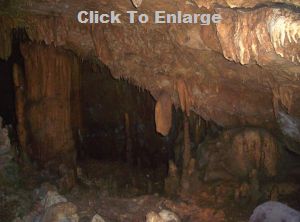 Located about 60 miles west of Tallahassee, Florida, just north of Interstate Highway 10, Florida Caverns State Park
is filled with natural wonders. The park contains 1,300 acres along the banks of the Chipola River. For a very small admission fee,
you will have access to the boat ramp, swimming area, picnic shelters, horseback riding facility, and the caves which are
open to the public. Florida sits on land which was once an ancient sea bed. The lime rock deposits underground are riddled with
thousands of caves, but due to the high ground water levels in the state, most of the caves are filled with water. Only in a few areas
are the caves dry enough to be explored without diving. Florida Caverns State Park is located on one of the highest land areas of
Florida. While many of the lower caves are water filled, some of the higher ones are dry enough to walk through. Underground streams
can be seen rushing through lower passages in the cavern complex on the level just below passages which are open to the public.
Located about 60 miles west of Tallahassee, Florida, just north of Interstate Highway 10, Florida Caverns State Park
is filled with natural wonders. The park contains 1,300 acres along the banks of the Chipola River. For a very small admission fee,
you will have access to the boat ramp, swimming area, picnic shelters, horseback riding facility, and the caves which are
open to the public. Florida sits on land which was once an ancient sea bed. The lime rock deposits underground are riddled with
thousands of caves, but due to the high ground water levels in the state, most of the caves are filled with water. Only in a few areas
are the caves dry enough to be explored without diving. Florida Caverns State Park is located on one of the highest land areas of
Florida. While many of the lower caves are water filled, some of the higher ones are dry enough to walk through. Underground streams
can be seen rushing through lower passages in the cavern complex on the level just below passages which are open to the public.
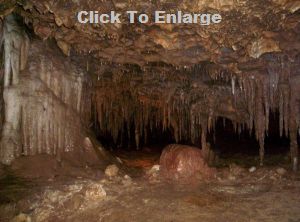 The park is located on land which has many large lime rock outcroppings. Numerous caves are in the park, but only those which are designated for public access many be explored. Access to some of the caves is restricted to avoid disturbing the wildlife that makes
its home in the underground passage ways. The area has been inhabited by humans since ancient times. Chert tools and pottery
found in the caves are evidence that there were Native American villages in the area. The caves were used to gather clay for the
making of pottery. The caves were discovered during the early Spanish explorations in Florida. A written description of the caves
can be found in the writings of Friar Barreda, dated 1693. Early Florida settlers came into the area and found an abundance of
natural resources. The ruins of a 19th century grist mill and a logging canal are within the boundaries of the park. The caves in the
park were used by Civil War refugees in the 1800s to hide from Union troops. They were also used by the Seminole Indians to hide
from Andrew Jackson's troops during the Florida Seminole Indian wars.
The park is located on land which has many large lime rock outcroppings. Numerous caves are in the park, but only those which are designated for public access many be explored. Access to some of the caves is restricted to avoid disturbing the wildlife that makes
its home in the underground passage ways. The area has been inhabited by humans since ancient times. Chert tools and pottery
found in the caves are evidence that there were Native American villages in the area. The caves were used to gather clay for the
making of pottery. The caves were discovered during the early Spanish explorations in Florida. A written description of the caves
can be found in the writings of Friar Barreda, dated 1693. Early Florida settlers came into the area and found an abundance of
natural resources. The ruins of a 19th century grist mill and a logging canal are within the boundaries of the park. The caves in the
park were used by Civil War refugees in the 1800s to hide from Union troops. They were also used by the Seminole Indians to hide
from Andrew Jackson's troops during the Florida Seminole Indian wars.
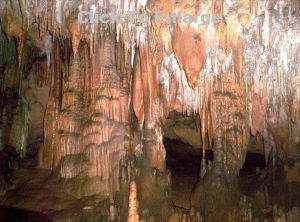 The caverns and surrounding land were originally purchased as a tourist attraction. After the land was acquired by the state, it became
Florida's seventh state park. Beginning in 1936, the Civilian Conservation Corps (CCC) worked to clear passage ways in the caves large
enough to walk through, even though some of the walk ways are still so low that an average size person still has to bend very low. The
work was hard and the material removed had to be carried out of the caves by hand in buckets. A stone work visitor center was constructed on the site, built from the local stone. The workers took care not to disturb the beautiful stone formations
in the caves any more than they had to. With great difficulty, they dug passages through solid rock into the dry chambers which contained the most amazing natural formations. Electric lights were installed in some of the chambers to light the way for cave visitors. Wiring was concealed and the lights were aimed to light the stalactites, stalagmites, columns, and other formations.
The caverns and surrounding land were originally purchased as a tourist attraction. After the land was acquired by the state, it became
Florida's seventh state park. Beginning in 1936, the Civilian Conservation Corps (CCC) worked to clear passage ways in the caves large
enough to walk through, even though some of the walk ways are still so low that an average size person still has to bend very low. The
work was hard and the material removed had to be carried out of the caves by hand in buckets. A stone work visitor center was constructed on the site, built from the local stone. The workers took care not to disturb the beautiful stone formations
in the caves any more than they had to. With great difficulty, they dug passages through solid rock into the dry chambers which contained the most amazing natural formations. Electric lights were installed in some of the chambers to light the way for cave visitors. Wiring was concealed and the lights were aimed to light the stalactites, stalagmites, columns, and other formations.
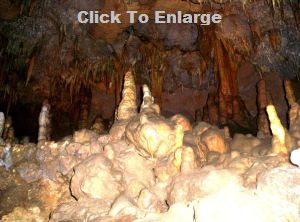 Stalactites are the inverted cone formations which hang from the roof of caves. Stalagmites are the cone shaped formations growing from the cave floor. When the stalactites and stalagmites meet and grow together, they form a column. The stone cave formations are formed over millions of years by tiny amounts of mineral that is dissolved in the water dripping from the ceiling of the caves. Only in caves that have some air circulation can the stalactites and stalagmites form. The mineral deposits are left due to the evaporation of some of the water in each drop that falls in the cave. Without some air circulation, no evaporation could occur. Different colors of the formations are the result of the different types of mineral dissolved in the water. The lighter colored stone is formed by lime from the water. The reddish colored stone is from iron in the water. It is estimated that only about an inch of stone is formed every 100 years. The huge stone formations in the caves took a very long time to form.
Stalactites are the inverted cone formations which hang from the roof of caves. Stalagmites are the cone shaped formations growing from the cave floor. When the stalactites and stalagmites meet and grow together, they form a column. The stone cave formations are formed over millions of years by tiny amounts of mineral that is dissolved in the water dripping from the ceiling of the caves. Only in caves that have some air circulation can the stalactites and stalagmites form. The mineral deposits are left due to the evaporation of some of the water in each drop that falls in the cave. Without some air circulation, no evaporation could occur. Different colors of the formations are the result of the different types of mineral dissolved in the water. The lighter colored stone is formed by lime from the water. The reddish colored stone is from iron in the water. It is estimated that only about an inch of stone is formed every 100 years. The huge stone formations in the caves took a very long time to form.
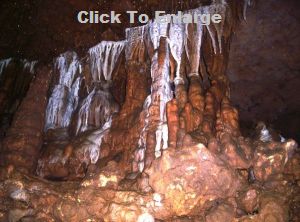 In the cavern which is open to the public, there is about a half mile of underground passages leading from chamber to chamber. Even with the electric lights, it is still dark and confining in the cavern. Water is constantly dripping from the roof of the chambers and the floor of the cave is always wet. The air is cool and damp. Each chamber visited reveals different formations where vistors can wonder at the natural stone formations and the long ages they took to solidify. Those wishing to see these natural wonders can take the guided tours starting from the Visitor's Center or venture into the caves alone if they wish. Photography is allowed in the caverns, but visitors are cautioned not to touch any formations in the caverns since even the tiny amount of oil on the skin can damage the stone which is still in the process of forming. On the guided tour, a park volunteer leads the group through the passages and relates some of the history of the area and how the weirdly shaped mineral deposits formed in the caverns through the ages.
In the cavern which is open to the public, there is about a half mile of underground passages leading from chamber to chamber. Even with the electric lights, it is still dark and confining in the cavern. Water is constantly dripping from the roof of the chambers and the floor of the cave is always wet. The air is cool and damp. Each chamber visited reveals different formations where vistors can wonder at the natural stone formations and the long ages they took to solidify. Those wishing to see these natural wonders can take the guided tours starting from the Visitor's Center or venture into the caves alone if they wish. Photography is allowed in the caverns, but visitors are cautioned not to touch any formations in the caverns since even the tiny amount of oil on the skin can damage the stone which is still in the process of forming. On the guided tour, a park volunteer leads the group through the passages and relates some of the history of the area and how the weirdly shaped mineral deposits formed in the caverns through the ages.
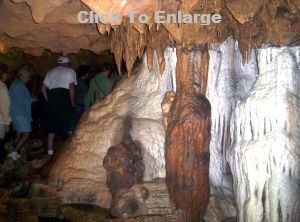 The caverns are the main attraction in the park, but many other activities may be enjoyed there. Canoe trips down the Chipola River would be an enjoyable way to spend an afternoon. A horseback ride through some of the trails which criss cross the park could give the visitor a view of the area from a different perspective. Natural springs bubble up from the water filled underground passages in the park where visitors can cool off in the crystal clear water. Fishing, hiking, and camping in the designated areas of the park give the public a chance to observe nature and spend some relaxing time away from the loud and crowded theme parks. Paved roads run through the park and cleared trails are marked for hiking. Just off the trails, the native plants and animals are undisturbed, giving guests a chance to see the area as it was before much of the native forests were destroyed by civilization. Many different kinds of trees can be seen in the park, which contains several distinct natural environments, from up-land hardwood forest to floodplain swamps.
The caverns are the main attraction in the park, but many other activities may be enjoyed there. Canoe trips down the Chipola River would be an enjoyable way to spend an afternoon. A horseback ride through some of the trails which criss cross the park could give the visitor a view of the area from a different perspective. Natural springs bubble up from the water filled underground passages in the park where visitors can cool off in the crystal clear water. Fishing, hiking, and camping in the designated areas of the park give the public a chance to observe nature and spend some relaxing time away from the loud and crowded theme parks. Paved roads run through the park and cleared trails are marked for hiking. Just off the trails, the native plants and animals are undisturbed, giving guests a chance to see the area as it was before much of the native forests were destroyed by civilization. Many different kinds of trees can be seen in the park, which contains several distinct natural environments, from up-land hardwood forest to floodplain swamps.
 Modern restrooms are available at convenient locations throughout the park. There is a Park Ranger station at the front gate. The Park Rangers patrol the grounds and will be happy to answer questions or assist those who need help. Maps and directions can be obtained at the park entrance. Pets are allowed in the park, but must be well behaved and be on a 6 foot leash at all times. No intoxicants or firearms are allowed in the park. The park is open from 8:00 AM Central Time until sunset, 365 days a year. It is the only Florida State Park that offers cave tours. The wide variety of recreational activities offered by the Florida Caverns State Park makes it one of the most attractive parks in the state. Anyone planning to travel through the west Florida panhandle should reserve some time to visit. Traveling on Interstate Highway 10, take exit 142. More specific directions are on the park website below. The park is also marked on most Florida state road maps. Take the time to stop and enjoy this beautiful park if you are passing through the area.
Modern restrooms are available at convenient locations throughout the park. There is a Park Ranger station at the front gate. The Park Rangers patrol the grounds and will be happy to answer questions or assist those who need help. Maps and directions can be obtained at the park entrance. Pets are allowed in the park, but must be well behaved and be on a 6 foot leash at all times. No intoxicants or firearms are allowed in the park. The park is open from 8:00 AM Central Time until sunset, 365 days a year. It is the only Florida State Park that offers cave tours. The wide variety of recreational activities offered by the Florida Caverns State Park makes it one of the most attractive parks in the state. Anyone planning to travel through the west Florida panhandle should reserve some time to visit. Traveling on Interstate Highway 10, take exit 142. More specific directions are on the park website below. The park is also marked on most Florida state road maps. Take the time to stop and enjoy this beautiful park if you are passing through the area.
**************************************************
~~To reserve prepaid camping facilities in the park~~
**************************************************
**************************************************
3345 Caverns Road
Marianna, FL 32446
Reserve America ~~ Phone 1-800-326-3521